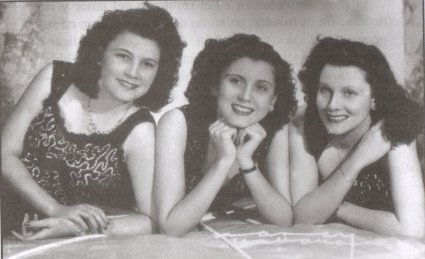10.6.1 The Lago Sisters Trio.

The Lago Sisters Trio was made up of Esperanza, Graciela, and Cristina. They were the children of Alberto Lago Suárez, a Spaniard, and María Muela, a Cuban-born couple. They were born in Havana in the legendary Jesús María neighborhood and comprise a total of nine siblings. They come from a notoriously musical family; their mother always sang beautiful songs, so they sang them from a very young age. Guitars, singing, and joy were a staple in the Lago family home. They studied for a time with guitar teacher Salazar Ramírez.
There was a first trio in the family called Los Hermanos Lago made up of Alberto (guitar), Pedro (mandolin) and Matilde (guitar).
In November 1932, Graciela, 14, Cristina, 13, and Esperanza, 12, at the suggestion of an uncle, entered an amateur competition. They won first prize for the female version and received thunderous applause from the audience. Thus, the trio Las Hermanas Lago was formed. From that moment on, they became professional and were hired a few days later as Cuba’s First Female Trio. Their format followed the trio format of the time: lead and second vocals; guitar and maracas. Initially, they followed the structure of the Trío Matamoros: two guitarists and a maraca player, using a lead and second vocal.
Their first performances took place in humble tents and theaters. On many occasions, both trios (Las Lagos and Los Lagos, who performed different genres) appeared in the same show, but the girls always won the audience’s applause.
Some time later, impresario Eduardo Muñoz (Sevillanito) hired them for a national tour, which they accompanied by their father. The tour was a huge success in the challenging field of Cuban popular music. Upon their return, the same impresario presented them on various stages in Havana. They performed in the country’s best theaters and, in 1936, were heard constantly on Radio Lavin, one of the best radio stations of the time.
That same year, Graciela decided to incorporate a third voice, something unusual in the formats of the time. Their repertoire included songs by the most prominent Cuban composers, including Miguel Matamoros, Rafael Ortiz, Ignacio Piñeiro, Sindo Garay, Salazar Ramírez, Manuel Corona, and María Teresa Vera. They also included other genres such as bambucos and tangos. The magnificent voices of Las Hermanas Lago included a variety of genres and themes.
From the start, the Lagos achieved success on highly acclaimed radio stations, quickly dominating the country’s radio audiences and sharing their performances with today’s most renowned artists, including the Gran Trío Matamoros, with whom they appear in theaters and also on Radio Latin.
In 1940, they performed on Cuba’s most famous radio station, the newly opened RHC Cadena Azul, as Cuba’s first female trio. They were under the tutelage and support of experienced pianist Isolina Carrillo, who arranged the best repertoire for them. Almost immediately, they were also hired by the CMQ radio station, where they were part of the program, La Corte Suprema del Arte (The Supreme Court of Art), featuring Cuba’s most prominent artistic figures. Seeking greater popularity, the station’s managers christened them Trío Circuito. The name change lasted only a short time, as the public recognized them as the Lago Sisters Trio.
The trio underwent several lineup changes for family reasons, but the high quality of their performances, the careful blending of their voices, and the rich instrumental handling of their strings were all unaffected. Esperanza decided to marry and moved away from music, replaced by Lucía. During this period, they began touring throughout Latin America. They achieved great success in theaters, nightclubs, and on the radio in countries such as Colombia, Peru, Venezuela, Argentina, Ecuador, Chile, Puerto Rico, Santo Domingo, and the southern United States.
Upon returning from tour, they formed a quartet with Esperanza, which lasted until her death in 1954.
In 1959, the Hermanas Lago trio expanded its performances and began performing in cultural centers and traditional music events, as genuine representatives of the intimate, romantic, and irreplaceable format of the troubadour trio.
In 1974, Cristina died, but Ofelia joined the trio. In 1981, Graciela and Ofelia retired from the stage. Lucía remained a soloist until 1989, when she retired.
They garnered international acclaim and won trophies and medals everywhere. From their beginnings, they dedicated themselves to promoting Cuban and Latin American songs with performances on major radio and television programs, as well as in important theaters and cabarets. They also appeared in several films: Rumba en televisión (Rumba on Television), Tropicana (Calle 72 No. 4504, Marianao, Havana), and No me olvides nunca (Never Forget Me), with Rosita Fornés and Luis Aguilar in the lead roles. In Buenos Aires, they filmed De Cuba traigo un cantar (From Cuba I Bring a Song). They shared the stage with important figures from the country; among their international artists are José Mojica, Jorge Negrete, Trío Los Panchos, María Félix, Luis Aguilar, Agustín Lara, Lucho Gatica, Alfredo Sadel, among others. They were the first to record children’s songs with great success. They were also the first to make a sung commercial, a jingle.
They are considered Cuba’s first harmonic trio. Their voices were a hallmark of Radio Cadena Habana for a long time. They were contributors to the Radio Habana Cuba radio team, heard around the world. For their work, in 1992, Radio Nacional awarded them the 70th Anniversary Microphone. They have received numerous awards, including: “Tenth Anniversary of Nueva Trova,” the Raúl Gómez García Distinction, “Distinction for National Culture,” and “Cultural Heritage of the Country.”








